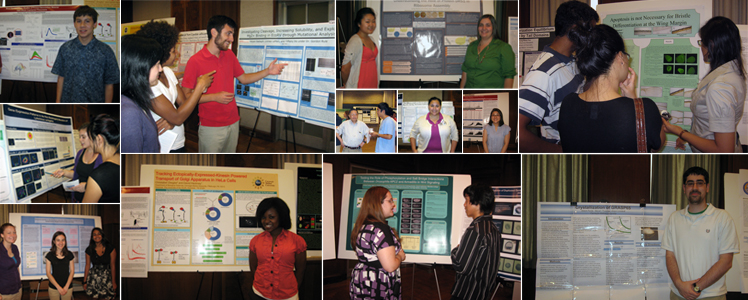Monday, August 9, 2010

The 2010 Summer Undergraduate Research Program Comes to a Close
A successful poster session and research symposium officially concluded the 2010 Summer Undergraduate Research Program (SURP) hosted by the Department of Biological Sciences. SURP is an umbrella program comprised of the National Science Foundation’s Research Experiences for Undergraduates (NSF-REU), Howard Hughes Medical Institute (HHMI) Scholars, HHMI Researchers, and HHMI Summer Research Institute (SRI). The 81 participants from Carnegie Mellon and other institutions conducted research with faculty mentors in cell biology, developmental biology, biochemistry, neuroscience and computational biology.
On July 28, 49 students presented at the SURP poster session on diverse topics such as the role of kinesin motor proteins in Golgi transport, mechanism of ribosome assembly, proteomic analysis of the ferret Primary Visual Cortex, sea urchin development, and the application of biosensors. Undergraduates, mentors, departmental staff and other members of the campus community attended the event.
On July 29, nine HHMI Scholars, nine NSF-REU participants and one HHMI Reseacher showcased their research during 10-minute presentations at the SURP Research Symposium. Hossam Abdou, an NSF-REU student in the Minden lab, utilized the innovative pHanTom plasmid to analyze autophagy in the mitochondria of DrosophilaS2 cells. Another NSF-REU student in the Hackney lab, Rosaline Lawrence, discussed her work on the mechanism of kinesin-associated transport in the mitochondria of HeLa cells. On the other hand, HHMI scholar and Mitchell Lab member, David Huang, characterized new adherence genes for the yeast species Candida albicans. Furthermore, Kelsey Briggs, an HHMI researcher from the Zappe lab, described the development of Agarose-based polymeric Microcapsules for neural stem-cell culture and tissue engineering. To view a complete listing of presentations, please visit http://www.cmu.edu/bio/research/undergrad_research/summer/schedule/week_10.html
“I really enjoyed my experience at Carnegie Mellon. The [SURP] program was a good way for me to get a glimpse of life as a researcher. Everyone in the lab was very helpful in teaching me different techniques, but I also had the opportunity to work independently," said NSF-REU participant Kristi Carter, who investigated the importance of phosphorylation and salt bridging in the Drosophila APC2 destruction complex in the McCartney lab.
Jasmine Keaser, another NSF-REU student had a similarly gratifying experience. “My graduate student mentor was very helpful and encouraging. By the end of the program I had a strong grasp on what graduate school would be like. It was rewarding to work on a project that would be carried on when I left, and to know that I was actually an important part of the lab, even though I was only there for a short time,” explained Keaser. During her time in the Schwartz lab, Keaser studied the population ancestry algorithm “unmixing” and its potential appliations in predicting the inheritance of disease causing genetic mutations.
SURP is aimed towards providing undergraduates with a strong platform to train in scientific research and prepare them for careers in the field through active participation in current laboratory. For more information on the program, please visit http://www.cmu.edu/bio/research/undergrad_research/summer/index.html